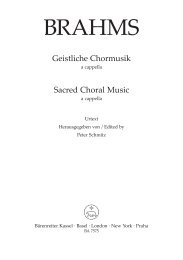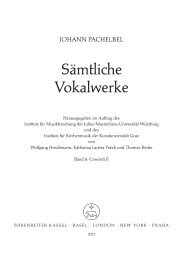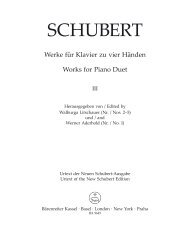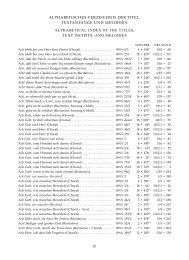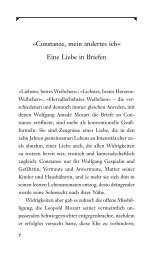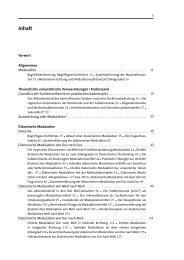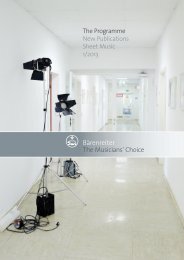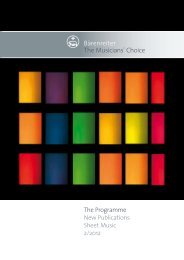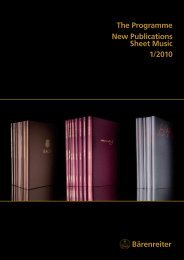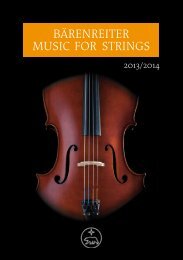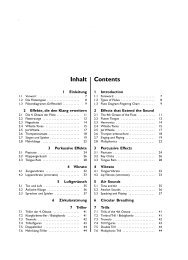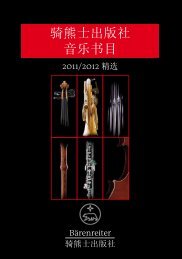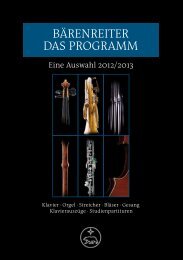MONVMENTA MONODICA MEDII AEVI - Bärenreiter Verlag
MONVMENTA MONODICA MEDII AEVI - Bärenreiter Verlag
MONVMENTA MONODICA MEDII AEVI - Bärenreiter Verlag
Create successful ePaper yourself
Turn your PDF publications into a flip-book with our unique Google optimized e-Paper software.
BeratergremiumWulf Arlt (Basel), Charles M. Atkinson (Columbus, Ohio),Giacomo Baroffio (Cremona), László Dobszay † (Budapest),Felix Heinzer (Stuttgart), Michel Huglo † (Baltimore),Ritva Maria Jacobsson (Stockholm), Susan Rankin (Cambridge)© 2013 <strong>Bärenreiter</strong>-<strong>Verlag</strong> Karl Vötterle GmbH und Co. KG, KasselAlle Rechte vorbehalten / 2013 / Printed in GermanyVervielfältigungen jeglicher Art sind verboten.ISMN 979-0-006-49610-5IV
To my parentsfor fostering my love of old songsvii
ContentsVOLUME ITextPrefaceList of IllustrationsList of TablesNote on Editorial ConventionsAbbreviationsvxiixivxvxviPART I. SOURCES1 In Search of Boethian Song 32 Scribes, Scholars and Schools 253 Notators and Notation 48PART II. ANALYTICAL APPROACHES4 Reading Neumatic Notation 795 Verse and Music 916 Models for Song 1187 Transforming Stichic Verse 135PART III. TRANSMISSION8 Individual Collections 1579 Regional Transmission 17410 Chronological Layers 185PART IV. IN CONTEXT11 Song Themes 20312 Performance Contexts 21213 The End of Singing Boethian Metra 234Bibliography 243Indexes 269ix
ContentsVOLUME IITranscriptions and CommentaryIntroductionIndex by MetrumviixPART I. INDIVIDUAL NOTATIONS1 BER 58 32 MU 18765 93 NA IV. G. 68 144 SG 844 385 EIN 302 406 EIN 149 427 LO 2685 438 LO 3095 469 LO 514 4710 TR 1093 4911 MU 15825 5512 WI 271 6113 PA 12961 6314 BE 455 6515 PA 7183 7216 CA O. 3. 7 7517 OX Auct. F. I. 15 7718 GEN 175 8919 PA 17814 11020 PA 14380 11221 CA Gg. V. 35 11522 ESC E. II. 1 12523 PA 13377 13324 VAT 3363 13525 OR 270 13726 BE 179 14027 PA 6401 14228 BE 181 14429 PA 1478 14830 ALE 12 15531 PA 1154 17632 VAT 1332 18133 ALB 98 18234 Pseudo-Odo 184x
ContentsPART II. SYNOPTIC TABLESI:1 Carmina qui quondam studio florente peregi 191I:2 Mens hebet et propria luce relicta 194I:4 Quisquis composito serenus aevo 197I:5 O stelliferi conditor orbis 198I:6 Cum Phoebi radiis grave 203I:7 Nubibus atris condita nullum 204II:1 Haec cum superba verterit vices dextra 209II:2 Si quantas rapidis flatibus incitus 210II:4 Quisquis volet perennem 212II.5 Felix nimium prior aetas 213II:6 Novimus quantas dederit ruinas 215II:8 Quod mundus stabili fide 216III:2 Quantas rerum flectat habenas 217III:3 Quamvis fluente dives auri gurgite 219III:5 Qui se volet esse potentem 220III:6 Omne hominum genus in terris simili surgit ab ortu 222III:8 Eheu quae miseros tramite devios 224III:9 O qui perpetua mundum ratione gubernas 225III:10 Huc omnes pariter venite capti 226III:11 Quisquis profunda mente vestigat verum 227III:12 Felix qui potuit boni 228IV:1 Sunt et enim pennae volucres mihi 230IV:3 Vela Neritii ducis 231IV:4 Quid tantos iuvat excitare motus 232IV:5 Si quis Arcturi sidera nescit 233IV:6 Si vis celsi iura tonantis 234IV:6/V:3 Si vis celis/Qvaenam discors 235IV:7 Bella bis quinis operatus annis 236AppendicesI. Kyrie Tropes 245II. Gloria Tropes 248xi
IllustrationsPlates1.1 MU 18765, fol. 16 r1.2 PA 13377, fol. 55 v1.3 PA 1478, fol. 17 v1.4 PA 1478, fol. 20 v3.1 OX Auct. F. IV. 263.2 Per viscera misericordiae, OX Auct. F. IV. 263.3 MU 9543, fol. 199 v3.4 BE 455, fol. 22 r3.5 BE 455, fol. 29 r3.6 Lines 1–6 of Heu quam praecipiti (I:2), NA IV. G. 68, fol. 6 v3.7 Felix nimium prior aetas (II:5), NA IV. G. 68, fol. 27 v3.8 SG 844, p. 1293.9 PA 17814, fol. 76 r4.1 Bella bis quinis (IV:7), PA 1154, fol. 119 v4.2 Bella bis quinis (IV:7), ALB 98, fol. 4 rFigures1.1 Durannus of Cluny’s ex dono, PA 1478, fol. 1 r3.1 Per viscera misericordiae (AM 73)4.1 Reconstructions of Bella bis quinis (IV:7) by Coussemaker and Gillingham4.2 Bella bis quinis in Pseudo-Odo, De musica4.3 Reconstruction of the melody for Bella bis quinis in ALB 98, fol. 4 r4.4 Neumatic notations for Bella bis quinis in EIN 149 and TR 10934.5 Reconstructions of melodies for Bella bis quinis in EIN 149 and TR 10934.6 O stelliferi (I:5), PA 1154, fol. 118 r4.7 Neumatic notations for Carmina qui quondam (I:1) in GEN 175, CA Gg. V. 35 andALE 124.8 Neumatic notations for Carmina qui quondam in BER 58 and OX Auct. F. I. 155.1 Opening trope element to Matins Verse In principio erat verbum, CircumcisionOffice, Beauvais5.2 Section of a two-part troped Benedicamus Domino, CA Ff. i. 17, fol. 8 r5.3 Melodies for Horace’s O fons Bandusiae (Odes III:13): PA 7979, fol. 8 r and VAT Reg.lat. 21, fol. 37 v (ed. Wälli, nos. 24 and 45)5.4 Rustica deflenti (line 2) aligned with a dactylic reading of O fons Bandusiae (ed.Wälli, no. 45)5.5 Si quantas rapidis (II:2), BE 181, fols. 17 r –18 v5.6 A realisation of the opening line of Si quantas rapidis in BE 181 according to aminor-third recitation model5.7 An expanded realisation of the opening line of Si quantas rapidis in BE 1815.8 A realisation of the opening two lines of Si quantas rapidis in BE 1815.9 Glosses and neumes added to Si quantas rapidis in BE 1815.10 Haec cum superba (II:1), PA 7183, fol. 26 r5.11 Recitation formula, tone V5.12 Intonation and medial cadence, tone Vxii
Illustrations5.13 Solvite templum intonation5.14 Melodic realisation for Haec cum superba (line 1) in PA 71835.15 Carmina qui quondam (lines 1 and 3) in GEN 1755.16 Opening halves of lines 1 and 3 of Carmina qui quondam in GEN 175 aligned withintonations and medial formulae for tones II and VIII5.17 Closing halves of lines 1 and 3 of Carmina qui quondam in GEN 175 aligned withcadential formulae for tones II and VIII5.18 The opening six hexameter lines of Carmina qui quondam in GEN 1755.19 Pentameter lines of Carmina qui quondam in GEN 1755.20 Iudicii signum, PA 2832, fols. 123 v –124 r6.1 Bella bis quinis in Pseudo-Odo, De musica6.2 Opening lines of Sanctorum meritis (BAR Ripoll 116, fol. 100 v ), O fons Bandusiae(PA 7979, fol. 8 r ) and Si quantas rapidis (BE 181, fol. 17 r )6.3 Horace Odes composed from Asclepiads and Glyconics with additionalPherecratean lines6.4 Opening lines of select Asclepiads6.5 Quisquis composito (I:4) and Squalent arvi6.6 Notations for Qui se volet (III:5)6.7 Qui se volet and Rex Christe, Martini6.8 Rex Christe, Martini, PA n. a. lat. 1235, fols. 171 v –172 r6.9 Conjectural reconstruction of Qui se volet as notated by Adelelm of Laon (d. 930)6.10 An alignment of neumed anapaestic dimeters8.1 Si vis celsi (IV:6), ALE 12, fol. 46 r8.2 A dactylic reading of notated metra in ALE 12 (group A)8.3 Paradigmatic reconstruction of group A in ALE 128.4 A dactylic reading of notated metra in ALE 12 (group B)8.5 Minor-third recitation in Natura potens and Heu quae miseros in ALE 128.6 A dactylic reading of notated metra in northern French manuscripts8.7 A dactylic reading of notated metra in NA IV. G. 688.8 Paradigmatic reconstruction of group A in NA IV. G. 688.9 Psalm Tones II and VIII, Commemoratio brevis8.10 Carmina qui quondam (lines1–2) in NA IV. G. 68, fol. 5 r8.11 A reconstruction of Carmina qui quondam, NA IV. G. 68, fol. 5 r8.12 Paradigmatic reconstruction of Qui se volet, NA IV. G. 68, fol. 41 v8.13 Haec cum superba (II:1, line 1) in NA IV. G. 68 and PA 71838.14 Reconstruction of the opening line of Haec cum superba in NA IV. G. 68 and PA 71838.15 Paradigmatic reconstruction of Felix nimium, NA IV. G. 68, fol. 27 v8.16 Quamvis fluente (III:3), NA IV. G. 68, fol. 39 r8.17 Episemata and significative letters in Quisquis volet perennem (II:4), NA IV. G. 68, fol. 24 v9.1 O stelliferi, I:5a—Eastern sources9.2 O stelliferi, I:5b—Western sources9.3 O stelliferi in VAT 3363 and PA 11549.4 Paradigmatic reconstruction of O stelliferi, VAT 3363, fol. VI v9.5 Paradigmatic reconstruction of O stelliferi, PA 1154, fol. 118 r9.6 Nubibus atris, I:7a—Eastern sources9.7 Nubibus atris, I:7b—Western sources9.8 Heu quam pracecipiti, I:2a—Eastern sources9.9 Heu quam praecipiti, I:2b—Western sources9.10 Bella bis quinis, IV:7a—Eastern sources and the Pseudo-Odo treatise13.1 The opening strophe and refrain of Olim sudor Herculis (FIR BML Plut. XXIX, fol. 417 r )xiii
TablesVolume I1.1 Manuscripts of the De consolatione philosophiae containing notated metra5.1 Metres used in the De consolatione philosophiae6.1 Patterns of melodic repetition in Qui se volet in NA IV. G. 68 and BE 4557.1 Ninth-century versions of Felix nimium prior aetas transmitted as an independent carmen11.1 Distribution of neumatic notation through the De consolatione philosophiae11.2 Notations per metrum aligned with metrical type and cadence patternVolume II1. The ordering of manuscriptsxiv
Note on Editorial ConventionsThe construction of manuscript sigla follows principles employed in the Corpus troporumseries. The holding library is indicated by an abbreviation of its town or city. Shelfmarksare shortened to numbers alone. Paris, Bibliothèque nationale de France latin 1154 isaccordingly referred to as PA 1154. The compact sigla that result are particularly usefulwhen compiling tables, in which the presentation of sigla is occasionally further compresseddue to restrictions of space. A list of manuscript sigla with full library references isprovided in the Bibliography.Metra within the De consolatione philosophiae are indicated by a twofold numerical system.Roman numerals in upper case refer to the relevant book; Arabic numerals refer tothe position of the metrum within each book. I:7 therefore refers to the seventh metrum inthe first book. Prose sections within the text are distinguished by adding pr. Thus I:pr.7indicates the first book, seventh prose segment.Neumes are transcribed with individual syllables of the text aligned down the page andsyllable numbers placed at the head of each example in order to ease comparison and reference.Two sets of brackets are used to indicate passages in which transcription is notstraightforward:Placement of neumes disturbed by other elements of the manuscript(e.g. by gloss)Neumes cannot be clearly discernedTextual transcription follows standard practice in parsing sung words into separate syllables.Abbreviations are silently realised and the cauda sign is transcribed as ae. Omitted textis provided in square brackets and grammatically incoherent abbreviations are realised in {}.< > are used to indicate corrections made in the source. Capitalisation has been standardisedwith capitals provided at the beginning of every poetic line and for proper nouns. Lineendingsthat do not correspond with poetic units are signalled by /. Punctuation signs havebeen reproduced in individual transcriptions using signs approximating to the original. Thetext and punctuation of the Loeb edition has been used for synoptic tables.Stemless note heads are used for transcription into modern notation in view of theabsence of precisely measurable rhythmic information in neumatic notation. Slurs indicateneumatic groups. The following signs are also employed:oriscusquilismaliquescencePitch-letters follow Guidonian, not modern practice:xv
AbbreviationsAH Analecta hymnica medii aevi, ed. G. M. Dreves, C. Blume and H. M. Bannister,55 vols. (Leipzig, 1886–1922)AM Antiphonale monasticum pro diurnis horis (Tournai, 1934)ASE Anglo-Saxon EnglandBEC Bibliothèque de l’École des ChartesBnFCAOParis, Bibliothèque nationale de FranceCorpus antiphonalium officii, ed. R.-J. Hesbert, 6 vols. (Rerum ecclesiasticarumdocumenta. Series maior, fontes VII–XII; Rome, 1963–79)CB Codices Boethiani, ed. L. Smith et al. (London, 1995– )CCM Corpus consuetudinum monasticarum (Sieburg, 1963– )CCSL Corpus Christianorum. Series Latina (Turnhout, 1953– )CSEL Corpus scriptorium ecclesiasticarum Latinorum (Vienna, 1866– )CT Corpus troporum (Stockholm, 1975– )EMH Early Music HistoryGL Grammatici Latini, ed. H. Keil, 8 vols. (Leipzig, 1855–80)Grove Grove Music Online, ed. D. L. Root GS Scriptores ecclesiastici de musica sacra, 1, ed. M. Gerbert (St Blasien, 1784)MB Mittelalterliche Bibliothekskataloge Deutschlands und der Schweiz, ed. P. Lehmannet al., 4 vols. (Munich, 1918– )MGG 1 Die Musik in Geschichte und Gegenwart, ed. F. Blume, 17 vols. (Kassel,1949–86)MGG 2 Die Musik in Geschichte und Gegenwart, rev. edn., ed. L. Finscher, 26 vols.(Kassel, 1994–2007)MGH Monumenta Germaniae historicaMMMA Monumenta monodica medii aevi, ed. B. Stäblein et al. (Kassel, 1956– )Mor. Boethius, De consolatione philosophiae, Opuscula theologica, ed. C. Moreschini(Munich, 2000)PAC Poetae Latini aevi Carolini, ed. E. Dümmler, L. Traube, P. von Winterfeld andK. Strecker, 5 vols. (Berlin, 1881–1951)PL Patrologiae cursus completus. Series Latina, ed. J.-P. Migne, 221 vols. (Paris,1841–61)PM Paléographie musicale: Les principaux manuscrits de chant grégorien,ambrosien, mozarabe, gallican1st series (PM 1 ), ed. J. Gajard and A. Mocquereau (Solesmes and Tournai,1901– )2nd series (PM 2 ), ed. J. Gajard, 2 vols. (Solesmes and Berne, 1900 and 1968)RBRHTS–KStRevue bénédictineRevue d’histoire des textesD. Schaller and E. Könsgen, Initia carminum latinorum saeculo undecimoantiquiorum: Bibliographisches Repertorium für die lateinische Dichtung der Antikeund des früheren Mittelalters (Göttingen, 1977); Supplementband, with the assistanceof J. Tagliabue (Göttingen, 2005)Hymnen: Die mittelalterlichen Hymnenmelodien des Abendlandes, ed. B. Stäblein(Monumenta monodica medii aevi, 1; Kassel and Basel, 1956)xvi
AbbreviationsTes.WThe Consolation of Philosophy, in Boethius: The Theological Tractates and TheConsolation of Philosophy, ed. E. K. Rand, trans. S. J. Tester (Loeb ClassicalLibrary, 74; Cambridge Mass., 1973)Melodien aus mittelalterlichen Horaz-Handschriften: Edition und Interpretation derQuellen, ed. S. Wälli (Monumenta monodica medii aevi, Subsidia 3; Kasseland Basel, 2002)xvii



